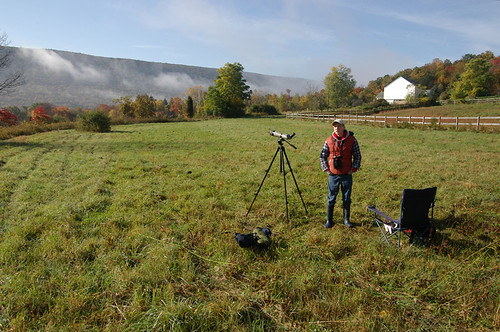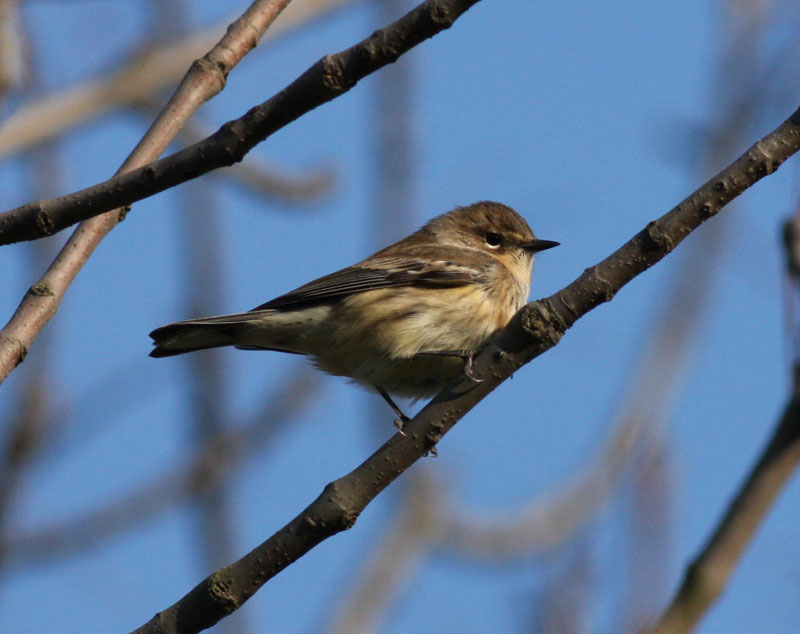On October 10, at 11:50pm, after a few hours of interrupted sleep, my dad and I headed out the Kunkletown Kingbird’s big sit circle in the field on our property. We got to the circle at midnight, and listened intently for any migrants, owls, or whatever might be calling. Not long after arriving in the circle, we heard the first bird of the day, a Chipping Sparrow. During the next few minutes, we heard several more flight calls from these sparrows. About 10 minutes in, the second bird of the day, a Swainson’s Thrush called while flying overhead. As with the sparrow, once the one called, many more started calling.
By 12:30, the lights in the neighbor’s house had gone out, and a disrupted Northern Cardinal chipped for a few seconds. Between for the next hour and a half, migrants were streaming overhead, calling frequently. Several common species were calling, but the best birds were Savannah Sparrow, Gray-cheeked Thrush, and American Bittern. AMERICAN BITTERN!!!!! This guy called several times while flying to the SE of the big sit circle. It sounded as if he was following the ridge rather than heading straight south. The bittern was a new bird for the yard.
Just before 2 o’clock, owls started up. I heard one Barred Owl, several Great Horned, and an Eastern Screech. That’s all of the expected owls. By 2am, the list stood at 12 species. The birds quieted for a bit, but a distant pack of Coyotes started up. Throughout the rest of the morning, more species called while flying over, including one unidentified bird making a duck-like “ehk”. Just before the sky started to brighten, the owls started up again, this time with 7 Barred, 7 Great Horned, and 3 Eastern Screech. When the Barreds started up, the dogs down in the valley started barking, but a series of gunshots from somewhere in the woods quieted the dogs, but not the owls.

Once the sky became ever-so-slightly lighter, a Saw-whet Owl made a drawn-out whistle from the field edge. Not long after the owl, an American Woodcock flew over, marking the beginning of the dawn chorus. Although the chorus was created mainly of common species, a few unexpected species sang or called, including a Brown Thrasher, Common Raven, and a Lincoln’s Sparrow. The Lincoln’s Sparrow was singing from atop an Eastern Redcedar. During the migration it can be hard to see these guys amongst the grasses, much less see one sitting on the top of a tree singing!
As the first sliver of the sun appeared over the mountaintop, a dense fog quickly rolled in. It hung over the field for close to an hour and a half, hiding any birds and muting their sounds. The heavy fog, mixed with the frigid air made for uncomfortable conditions while participating in The Big Sit!. Fortunately, when the fog lifted, the birds were still very active. Throughout the morning I (my dad had left sometime in the predawn hours) checked off species as they appeared. The birding was good until around 11:00, when the day got an early start to the afternoon lull.
Sharp-shinned Hawks darted past, most continuing south, others diving into the trees near my circle. At some point, a large flock of sparrows flew at me from across the field, and landed in the autumn olives directly behind me. The flock was mostly White-throated Sparrows, but there were also Song, Field, Chipping, and two unexpected White-crowned Sparrows. The sparrows hung out for about 30 seconds before disappearing into the brush.
The sun warmed up the air, which started up the raptor migration. Many more sharpies flew past, as well as Merlins, and Cooper’s and Red-tailed Hawks. A Northern Goshawk flew directly south over the ridge I was situated upon, but turned SW to follow the Kittatinny Ridge. Small kettles of accipiters and Turkey Vultures formed throughout the day, but only lasted for a few minutes.

The afternoon was slow, new species continued to appear, but at 30, 45, or even 60 minute intervals. Occasionally, a new raptor would show up, most flying among the masses of Sharp-shinned Hawks. I was able to find Northern Harrier, Peregrine Falcon, Osprey, and Bald Eagle, but could not manage to find any buteos other than red-tails. At one point, I was watching a kettle of Cooper’s and Sharp-shinned Hawks when a large bird flew into the view of the scope. I followed the bird as it lost altitude and flew closer. It turned out to be a Herring Gull that for some reason was pretending to be a southbound raptor for the day.
The late afternoon brought a final rush of birds, including many warblers that I had probably missed in the foggy morning. Pine, Nashville, Palm, and Blackpoll Warblers hung out around the field for a while, until disappearing into the sunset. The Blackpoll Warbler was the final bird of the day. I headed inside and retired around 9:00 and tallied up the list before heading to bed. I had ended up with 70 species, not bad considering my previous yard record had been 49.
The full list:
1. American Bittern*
2. Great Blue Heron
3. Turkey Vulture
4. Canada Goose
5. Mallard
6. Osprey
7. Bald Eagle
8. Northern Harrier
9. Cooper's Hawk
10. Northern Goshawk
11. Sharp-shinned Hawk
12. Red-tailed Hawk
13. Peregrine Falcon
14. Merlin
15. American Woodcock
16. Herring Gull
17. Mourning Dove
18. Eastern Screech-Owl
19. Great Horned Owl
20. Barred Owl
21. Northern Saw-whet Owl
22. Red-bellied Woodpecker
23. Downy Woodpecker
24. Hairy Woodpecker
25. Northern Flicker
26. Pileated Woodpecker
27. Eastern Phoebe
28. Red-eyed Vireo
29. Blue Jay
30. Common Raven
31. American Crow
32. Tree Swallow
33. Black-capped Chickadee
34. Tufted Titmouse
35. White-breasted Nuthatch
36. Carolina Wren
37. House Wren
38. Golden-crowned Kinglet
39. Ruby-crowned Kinglet
40. Eastern Bluebird
41. Swainson's Thrush
42. Gray-cheeked Thrush
43. Hermit Thrush
44. American Robin
45. Gray Catbird
46. Northern Mockingbird
47. Brown Thrasher
48. European Starling
49. American Pipit
50. Cedar Waxwing
51. Nashville Warbler
52. Blackpoll Warbler
53. Yellow-rumped Warbler
54. Pine Warbler
55. Palm Warbler
56. Eastern Towhee
57. Chipping Sparrow
58. Field Sparrow
59. Savannah Sparrow
60. Song Sparrow
61. Lincoln's Sparrow
62. White-throated Sparrow
63. White-crowned Sparrow
64. Dark-eyed Junco
65. Northern Cardinal
66. Common Grackle
67. House Finch
68. Purple Finch
69. American Goldfinch
70. House Sparrow
*a new species for the yard

2 comments:
Awesome, looks like you live in a cool spot, nothing like my neighborhood. Also looks like the fall has caught up to you in Kunkletown, North Carolina is still green. Nice Yard Bird!
Wow..you always impress me...congrats on a wonderful Big Sit!
I enjoyed every bit of this post!
Post a Comment